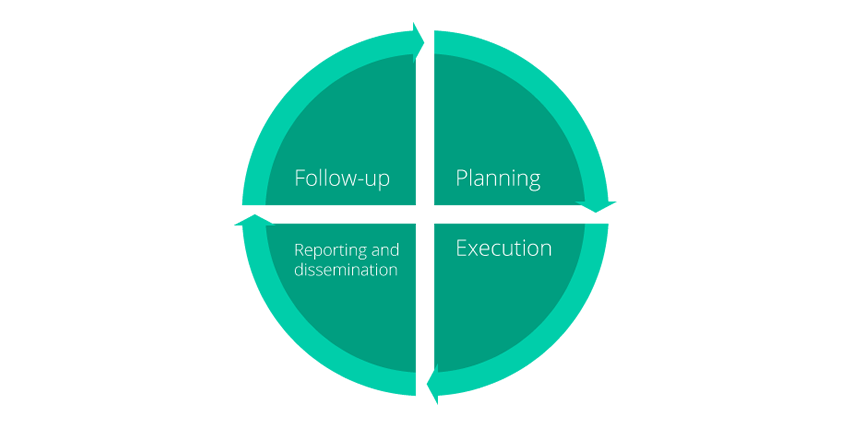The audit Process
The audit process can be classified into four different phases:
- audit planning;
- execution (field work, evidence gathering, and drafting of the report);
- reporting and dissemination (submission of the report to the authorities and dissemination); and
- follow-up (monitoring of the auditee’s actions).
Citizen collaboration can take place in each phase of the audit cycle:


Planning:
In Oman, citizens can provide valuable input to audit planning through the SFAAI Smart Phone Apps, an online system the State Financial and Administrative Audit Institution launched in 2011 to receive complaints and reports that could help detect financial and administrative deviations in public sector companies. That feedback mechanism has achieved impressive results during the first two years in practice, as citizens have reported more than 600 financial violations and complaints regarding misuse of power and improper bids, among others.
Execution:
In India, social audits are supported by the SAI to engage credible citizens’ groups whose members have expertise in specific areas. Through active media coverage of forthcoming audit exercises, the Comptroller and Auditor General of India (CAG) invites those groups to share suggestions and information regarding the subject matter. This activity has expanded the CAG´s outreach and allowed auditors to get deeper insight into the auditees’ business, thereby leading to better-rounded audit reports.
Reporting and dissemination:
In Montenegro, the State Audit Institution summarizes key findings and recommendations of individual audit reports in its annual report of audit reports. That summary reports which laws were violated most often, along with an explicit account of how many and which of its recommendations from the previous year were implemented. The dissemination of this kind of information, together with individual audit reports, is critical to ensuring that corrective actions are undertaken. For instance, the Institut Alternativa, a local research CSO, has begun to monitor SAI’s effectiveness by checking to see if the audit entities comply with deadlines and reporting back to the SAI about what has been done to address the recommendations. Support from civil society can stir up attention about specific aspects of SAI work, get media coverage, and contribute to exerting pressure on auditees so that they address the irregularities detected in audit exercises.
Follow-up:
In South Africa, audit reports are published and thoroughly disseminated. Using the audit findings, the Public Service Accountability Monitor (PSAM)—a research and advocacy organization—works closely with the national legislature to track government agency responses to instances of financial misconduct and corruption identified by the Auditor General to pressure governments to take corrective action. PSAM publicizes audit findings in press releases and on radio talk shows, publishes a scorecard measuring the comparative compliance of various provincial agencies with public finance law, and organizes public campaigns highlighting the large number of audit disclaimers issued by provincial audit entities, all of which has led to stronger financial management practices in provincial government agencies.
Who are the relevant actors during the audit process, and what are their roles?
- The Auditors: The Head of the SAI and the persons to whom the task of conducting audits is delegated. The responsibility of auditing the public sector is defined by the SAI’s mandate, which is established by law.
- The Auditees: Governments and other public-sector entities that are accountable for the use of resources derived from taxation and other sources in the delivery of services to citizens and other recipients and are therefore subject to public enquiry by the SAI.
- The Parliament: The role of parliament varies from SAI to SAI. In most countries, SAIs are auxiliary to the Legislature, which is responsible for authorizing national budget and public accounts that in turn are subject to SAI examination. Normally, a Public Accounts Committee is the nexus between the SAI and the Parliament.
- The Beneficiaries: Citizens are the ultimate beneficiaries of SAI’s work. Civil society organizations, the media and other intermediate stakeholders are also beneficiaries of audit reports, as they usually serve as bridges between public agencies and citizens.
Source: http://www.e-participatoryaudit.org/module-01/audit102-1.php
